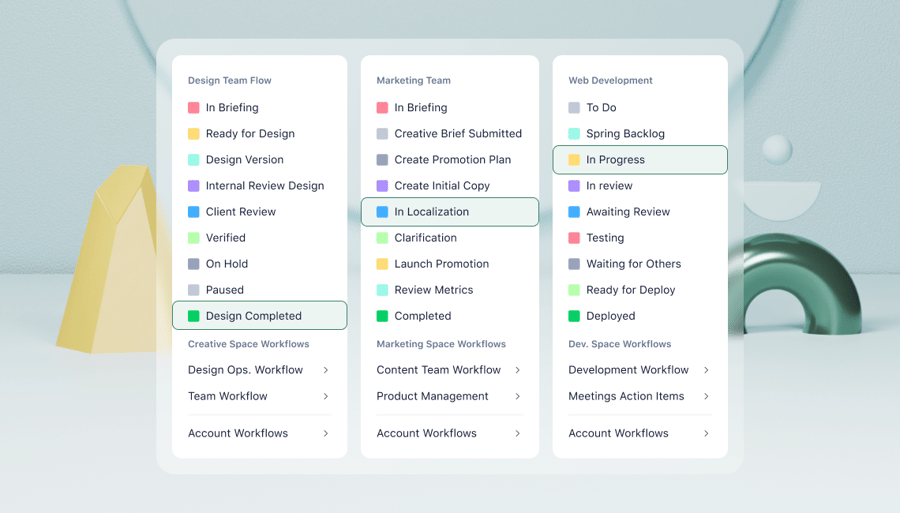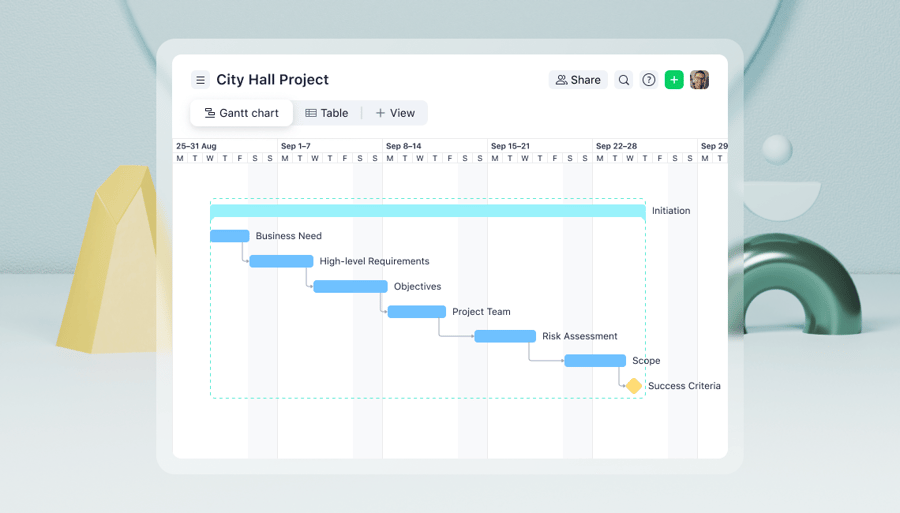Key takeaways:
- What is workload management? Workload management is the process of distributing tasks and resources within a team to efficiently complete projects and meet goals.
- Why is workload management important? It optimizes resource allocation, enhances project planning, reduces employee burnout, improves team morale, and fosters collaboration.
- How do you analyze workloads? Begin with a workload analysis to identify imbalances and improve current work processes by reviewing project assignments, approvals, and task durations.
- What are key tips for managing workloads? Set clear goals, allocate resources wisely, establish roles, prioritize tasks, and monitor progress while encouraging open communication.
- How can Wrike help with workload management? Wrike offers templates and tools for planning, delegating, and tracking projects, making it easier to manage workloads effectively.
Recent rapid innovation in business technologies has led to a compounding increase in work speed and profits but has not impacted employee work hours or workload in the same way. As tech evolves to solve old problems, new (and sometimes more complex) ones emerge, leaving employees stretched and seeking fast-acting productivity tips and tricks to get the most out of each workday.
Efficient workload management helps project managers and teams maximize productivity while reducing the risk of overwork or burnout.
This article looks at several strategies for creating an effective workload management system. We’ll share 10 tips and five steps for analyzing and managing team workloads and discuss how to create a streamlined process using Wrike’s project management software.
What is workload management?
Workload management is the process of identifying, prioritizing, and distributing tasks, responsibilities, and resources within a team to complete projects and achieve set goals.
The process is two-pronged. On the one hand is the planning, i.e., identifying and allocating necessary resources (such as time, personnel, budget, and materials) to mobilize teams and activate projects.
On the other are workflows and business process management, i.e., defining roles and expectations and establishing structure and systems that allow team members to work better together to deliver successful projects consistently.
Why is workload management important?
Effective workload management helps managers make the best of all available resources. Team members’ strengths and capacities are taken into account for each new project, and performance over time is tracked to gather insights for future project planning.
With workload planning and management, teams reduce instances of social loafing – a situation where some team members do less work in a group, leaving others to pick up the slack and carry the project to completion.
Other important benefits of workload management include:
- Improves project planning: Intentional workload management gathers data showing team and individual capacity and throughput, estimated task durations, and the reach of critical project resources. Over time, these become valuable insights that help project managers improve future project planning.
- Reduces wastage: Workload management tracks shared resources in an organization. Whether relating to staff, materials, cost, or time, workload management helps teams ensure that organizational resources are optimally allocated and used to achieve the company’s primary goals. Implementing workload management software within team workflows makes it easy for all involved to see where there may be wastage or surplus.
- Facilitates successful project delivery: Organizations with effective workload management processes position employees to do their best work within reasonable timeframes. This creates room for employees to deliver quality work, maintain mental health, and achieve consistent success. Teams with good workload management practices are more focused and engaged and produce better results overall.
- Improves team morale: Without workload management, social loafing and other negative work behaviors may run unchecked, leading to a decrease in employee productivity and morale. Those who work hard may become demotivated to do so, whereas those who do little may never have a chance to grow. Effective workload management ensures everyone contributes to their maximum ability, with just enough challenges to help them learn and improve without burnout.
- Streamlines collaboration: Lastly, workload management fosters a work environment that promotes open communication, feedback-sharing, and team collaboration to achieve set goals. Managers can decide how best to share available resources, delegate, and communicate timelines with team members. Team members can speak to managers when they are overwhelmed by their workloads or seek support from their team members.
How do you analyze workloads?
To manage team workloads effectively, you must begin with a workload analysis. Think about what you hope to achieve with your workload management efforts, e.g., improve team productivity, identify underperforming resources, or reduce overwork amongst star players in the team.
When you know your desired outcome, you can begin a workload analysis to identify imbalances and spot areas for improvement in your current work processes and systems.
Ask:
- How are projects broken down and assigned to team members?
- Who reviews and approves deliverables?
- How long do recurring tasks take? Can they be eliminated with workflow automation tools?
- Are too many or too few resources allocated to specific projects?
Review who does what and examine team members’ responsibilities and workloads. Note gaps and possible adjustments you can make to improve the workflow and workload distribution. Then, meet with your team to hear from them and gather input on how they feel about and manage their workloads.
Once you have these insights, you can begin to take action to address the gaps and manage team workloads more fairly and effectively. Regularly review your team’s performance to see how well the workload changes are working. Be open to revising and adjusting your process as needed.
10 top tips for managing employee workloads
There are several approaches to managing employee workloads. Depending on an organization’s systems and outputs, leaders may focus on strategies such as time tracking and management, task prioritization, or automated workload management tools.
Regardless of your organization’s approach, the following tips can make you better at managing employee workloads:
- Set clear goals and objectives: Company leaders and managers must take time to clarify the primary goals and objectives for the coming period or project. Setting goals makes it clear to everyone involved what needs to be accomplished and how they may be involved. Goals define a project’s scope, team size, and boundaries or similarities with other ongoing projects.
- Identify and allocate resources: From goals, project managers can devise a plan for sharing the workload and matching team members’ strengths and abilities to the tasks involved. Resources such as time, materials, equipment, and budget are also shared at this stage.
- Establish roles and a chain of command: Depending on the project team’s size and scope, it may be necessary to define roles and responsibilities within the team to ensure work moves through each phase and is up to standard. Defining roles involves delegating responsibilities to specific team members or groups, keeping everyone aware of what their team members are up to and what they need to do next.
- Prioritize tasks: Task prioritization helps managers and employees channel their daily focus efficiently by identifying and working on the most important or urgent tasks first. Tasks can be prioritized based on urgency, importance, strategic alignment, or return on investment (ROI).
- Create a schedule or timeline: Developing a work schedule or timeline helps break larger tasks or projects into manageable bits and ensure projects are completed on time. A work breakdown structure (WBS) is useful for this stage. Wrike offers a WBS template to simplify the process and save time starting from scratch with each new project.
- Monitor progress and adjust plans as needed: Workload management continues beyond creating project plans and schedules. Assessing team and individual performance and project progress while a project is underway helps uncover constraints, potential risks, or schedule conflicts, allowing teams to mitigate them proactively.
- Communicate clearly with team members: Team communication is a cornerstone of workload management. This helps identify potential issues or bottlenecks before they become major problems. Encourage open communication about workloads, expectations, and deadlines. It’s best to use work management software to streamline project-related conversations and ensure everyone is on the same page at all times.
- Track and manage task durations: Monitor and review the time it takes to complete recurring project tasks. This provides comprehensive data that helps you deliver more successful projects and cater to employees’ abilities without stretching them too thin. Review each one’s progress and adjust their workloads if you notice anyone struggling. This may mean adjusting the project scope for the team or redistributing tasks for the individual. Encourage team members to use their time efficiently and minimize distractions while on the clock.
- Seek help or support when needed: Advise team members to proactively seek help when overwhelmed with their current workloads. Rather than miss a deadline or let scheduled tasks fall to the side, they can seek help from other team members or speak to a manager. In situations where everyone has a lot on their plate, managers can review the task priorities to see what can be moved to the backburner or consider delegating some tasks to support staff or external contributors.
- Provide training: Consider providing additional training or resources to team members struggling to keep up with their workload. This can help build their skills and increase their capacity to take on more tasks, increasing the company’s overall workload capacity.
Five essential steps of effective workload management
Now, we get to the heart of creating a workload management process. Follow the steps below to help you manage employee workloads:
1. Start with a project plan template
Before managing employee workloads, you must begin with a defined project plan. This helps you set clear goals and break them down into projects and tasks your team can handle within a reasonable timeframe.
Use a project plan template to standardize your project planning and save time creating and organizing new projects. With a template, you can kick-start similar projects quickly by simply copying your template into a new project folder and adjusting the dates, scope, and other details.
Project plan templates improve visibility into your entire work plan. They serve as one-stop documents to gather and manage all the moving parts of your projects: timelines, roles, due dates, and allocated resources can all be entered, updated, and communicated using a project plan template.
2. Consider your team’s current bandwidth vs. current workload
Once your project plan is laid out, the next step is to check and align the workload with your team’s capacity. Workload management software lets you see team members’ itemized workloads and availability, helping you gather a realistic account of how much your team can do and how quickly. These insights enable you to plan more confidently, maximize available resources, and reduce the chances of overworking any team member.
Keep the following considerations in mind when considering team bandwidth vs. current workload:
- Upcoming and current projects: Look at the projects that are currently underway or coming up soon. Consider how much time and resources each one will require and how it will impact the team’s workload.
- Employee vacation time (PTO): Reviewing your team members’ vacation and PTO schedule ensures you know exactly how many people will be available to work on projects at any given time.
- Areas of expertise: Consider the skills and expertise of your team members. Are there certain tasks only specific team members can handle? Note their availability and organize the workload to take this into account.
- Individual and team capacity: Consider the bandwidth of your team members. Are they able to take on additional work or are they already stretched thin? If the team is at capacity, it may be necessary to postpone less-important projects or bring on support staff or external contributors.
- Project prioritization: Evaluate the priority of each project and determine which ones should take precedence. This helps ensure the most critical tasks are completed on time, even if other less essential ones are delayed.
3. Delegate tasks by urgency and skill set
After sorting out your team’s availability, the next step is to delegate the project tasks by urgency and skill set. This will inform the critical path of your project workflows and timing, and also the workload of each team member.
You can use project prioritization methods such as MoSCoW or the Eisenhower Matrix to ensure the most urgent and important tasks are tackled first. Share your matrix with team members to enable them to understand what tasks are important and why; then, assign the highest priority tasks to the best-suited team members.
Workload management software comes in handy here. These tools make it easy to sort and communicate project task priorities and manage workloads according to team and individual capacity. When considering which team member should complete each task, look at their skill set as well as capacity and availability. Can they take on this new task and do a great job on time?
Keep the following considerations in mind when prioritizing and delegating tasks:
- Project timelines: Identify your critical path – tasks that must be completed before others can start – to meet project deadlines and delegate them to the best-suited team members or groups. Then, move on to the less-critical tasks and assign them to other available team members, taking into account their strengths and availability. Ensure that you allow some free slack time in your project timeline scheduling to ensure that deliverables are turned in earlier or on time, not later.
- Scope of work: Make sure the delegated tasks cover the project’s overall scope and team members understand how their work fits into the bigger picture. Review the main goal and assigned tasks. You may find missed gaps or opportunities to break down mid-sized tasks into even smaller bits for faster execution.
- Team skill set: Your team’s skills, abilities, and commitment are crucial to managing workloads and maximizing resources. If a project is sensitive, urgent, or high-value, you want to work with the most dependable and experienced team members. But you don’t want to overwork them and leave others with little to do. Find a balance to keep your star players engaged, motivated, and committed while training others to maximize their strengths.
- Resource allocation: Sometimes, multiple ongoing projects in an organization may require the same resources at the same time. Encourage managers to work together to share and allocate resources (e.g., talent, time, budget, and materials) to the various tasks in order of priority.
- Change and risk management: Consider any potential risks or challenges that may arise as team members work on their project tasks. Develop and communicate contingency plans to address risks if they occur. This helps prevent bottlenecks with executive permission and empowers team members to manage their workloads and keep projects moving.
4. Set performance expectations with your team
Now you have your project plan and have allocated resources and tasks to team members, you must set clear performance expectations with everyone involved, be they in-house teams or external collaborators.
Clarify and communicate standards for delivery. Let team members know what would qualify as a successful task or project. Will a minimum viable product (MVP) suffice? Or do sponsors expect a fully complete product?
Communicating performance expectations ensures project task outputs are up to standard, leading to improved customer and stakeholder satisfaction. Two common ways of qualifying performance expectations are:
- Agile project management: Agile teams work in short sprints and focus on improving and delivering increasing value over time.
- Traditional project management: Teams work with a traditional management technique and focus on creating perfect outcomes right off the bat.
Work management platforms provide tools such as Kanban boards for easy updates and collaboration, Gantt charts to track project timelines and progress, and real-time reports that show when you’re deviating from set goals or deadlines. These tools synchronize workload planning and management with performance tracking, meaning you’re more likely to attain success.
5. Be flexible and adapt as needed
At this point, most of the hard work of workload management is done. Monitoring the project’s progress, resource availability, and the external environment helps you predict and mitigate risks before they become huge problems or hinder the entire project.
Regularly review and assess project progress and team performance and make any necessary changes to the plan. This may involve reassessing priorities, adjusting timelines, or seeking additional resources or support.
Unexpected issues, such as a team member falling sick, can throw your project off course if you do not have a change management process set up. Be open to receiving employee and stakeholder feedback as well as iterating to produce better results for the team and organization.
Use workload management tools and software from Wrike
Work management platforms such as Wrike take away the complexities of workload management. Wrike provides templates and virtual collaborative workspaces for planning, delegating, and tracking project performance from start to finish.
Wrike also offers workflow automation functionalities that help teams save time spent on repetitive, low-value work, e.g., updating spreadsheets and preparing and sharing reports. With these features, company leaders and managers can easily manage their workloads with less effort.
In addition, Wrike provides a workload view to simplify team and workload management further. Using the workload view lets managers see at a glance what all team members have going on in a specified period. You can zoom in or out. The view is dynamic and interactive, allowing you to make changes and optimize workflow action items. When you make a change to an ongoing project, the new assignments and updates are automatically shared with the team via email notifications and Wrike activity streams.
Are you ready to take control of your workload management process and design better systems for your teams to contribute their best work in good health? Try Wrike’s work management platform today. Get started with a free two-week trial.









